The St. Peter’s Lutheran Church leadership wanted to share some Frequently Asked Questions with you regarding in-person worship and church gatherings.
In March 2020 the St. Peter’s Lutheran Church leadership suspended worship because of the covid-19 virus outbreak. We are all longing to be back in church as we were before this health crisis hit. We have a dedicated group of people on our Safe Church committee who have been working hard to keep updated on CDC recommendations and have been working in conjunction with the staff, the Worship Committee and the Church council as it pertains to our church life. We hope the following FAQ may be a useful communication in our shared faith life together.
When will we return to worship in the Sanctuary?
First of all, please know that all of us want to be back in person to worship. Unfortunately, we were ready to be back in November when our Covid numbers rose greatly. With the information from the CDC, local school districts, our medical personnel and the office of our Bishop, we decided to wait until our numbers began to decrease.
Why are other churches holding in-person worship?
These are decisions made by individual churches and their denominational structures. Some of these churches do not have the ability to livestream a service. Other churches are strictly holding outdoor worship. We are aware that church gatherings are one of the riskier gatherings to attend and that singing is also a way for the virus to spread.
Why can’t we worship, but groups are allowed to gather in the church?
We are allowing groups of less than 20 to gather and socially distant. Some of these groups include AA, AL anon, our widows’ group, and other small groups. As things improve, we will be adding more indoor group gatherings. Volunteers who are our carryout service ministries of quilting, Lydia’s closet and our community meals are also allowed in the building.
Most people don’t get that sick, why can’t those who want to worship, be able to worship in our sanctuary if we social distance?
We follow the guidelines of the CDC, our Bishop, what is happening in our local school districts and the PA department of health. We are also very aware that while you may not get sick, you can also be a spreader of the virus. As people who carry out the command of Jesus, “to love our neighbor,” we take the health and well being of our parishioners very seriously. We also need to remember that we are putting our staff and volunteers at risk, as well.
What will worship look like when we return?
Until most of us get the vaccine and we begin to see herd immunity, our in-person worship services will be a 30-minute service that will NOT include communal singing. While we will celebrate the Eucharist, it will look a bit different. We will not be communing at the rail, but in the pews with prepackaged elements. Offering will be dropped off in a box as you enter the sanctuary and we will discourage congregating in the narthex after the service.
Most likely the service will take place at 8:00 am which will allow enough time in between this service and the live stream since we will need to clean the sanctuary beforehand. As we are able to control the virus, we will be adding to our worship life.
There will be a limit to the number of worshippers per service, as well. According to the PA Department of Health, the guideline for congregant settings is 10 percent of maximum occupancy which translates to 54 persons, including worship leaders and volunteers. While churches may be exempt from this, we feel it is necessary to follow to keep our parishioners and staff safe. Call ahead reservations will be encouraged at the beginning.
Why is singing such a problem for spreading Covid-19?
When we sing we are forcing air up through our respiratory tract in a more forceful way. On its way out, the air takes any dislodged particles along with it. These particles are aerosolized and these aerosolized particles carry the virus which can be breathed in. In an enclosed space, without ventilation, these particles can build up to levels which can cause infection. For these reasons, singing together has been identified as contributing to the so-called “super-spreader” events.
The safe church committee, worship committee, council, and worship staff have had numerous lengthy conversations surrounding worship, how we will gather, and what our gatherings will look like. Throughout these conversations, one thing has been at the forefront of our decision-making, namely that we make every effort to protect and serve the most vulnerable among us while retaining our sense of community. For now, this means that when we gather together indoors, we will show our love for our neighbor by refraining from singing together. Music during worship will be instrumental in nature, but to every extent that is possible, will still relate to the Gospel message for the day.
Last updated January 27, 2021
